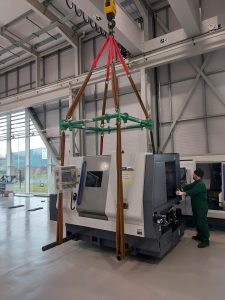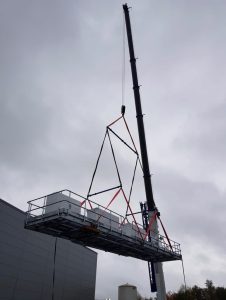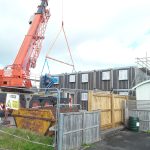Air Handling Units – Are you lifting them legally?
Roof-mounted air handling units are an essential part of any commercial or public building. But the processes and equipment used to lift them into place often fall short of best practice – and in some cases could be breaking the law.
Crane lifting of air handling units (AHUs), sometimes refered to as ‘coolers’, is so commonplace that it’s easy to assume it’s done safely and to the letter of the law. However, in Britlift’s experience, nothing could be further from the truth.
The main issue is, AHUs don’t always come with lifting points. Some units may have integral forklift pockets for ease of shipping, whilst others might have profiled holes within the units base structure, but manufacturers don’t seem interested in what happens after an AHU is unloaded from the truck.
The lack of lifting points means that the installer has to find a solution, and this is where the problem lies. Some installers will just loop underneath the AHU – “basketing” – while others will procure a lifting bar (a lifting bar is not used above the load -spreader beam or lifting beam- but below or through the base for connection to the load). But in both cases, there could be implications.
Legal responsibility
We’re immediately into what is perceived as grey area here, as to who is legally responsible for whatever equipment is attached to the unit for lifting. Some AHU manufacturers will specify a size of steel bar or section that can be used as a lifting bar (slid underneath or through the base), but they don’t supply it; the installer has to source and procure themselves. The OEM’s point of view is that they are not supplying it, so they are not responsible for ensuring it is correctly rated and marked as a piece of lifting equipment. Potentially the OEM is actually completely unaware of the legislation that governs such equipment. If they are a multinational company they will cite the “local legislation” defence and leave it to the installers to sort out.
The installer will say it is nothing to do with them as the manufacturer has specified (designed) the item, so they believe that they are not responsible to ensure it conforms with legislation, either. They often believe a load test is all that is required (commonly called a “LOLER Certificate”) but this is not the case, and there is a lot more to it, with other documentation and requirements!
Another reason that this is viewed as a grey area is, a piece of lifting equipment is subject to LOLER but something that is part of the load is not. Far too often, these beams are considered part of the load by OEM’s/installers when they absolutely are not. They are detachable, and can be reused time and again, for multiple lifts, so they are regulated by LOLER and the Supply of Machinery Safety Regulations (SOMSR).
Below is an example of the sort of thing we are seeing too frequently, but this specific example is a CNC machine being lifted within a factory, using unsuitable, uncertified, unmarked, illegal and dangerous lifting bars (bits of tube) through the base. Whilst this isn’t an AHU it does give a really good visual example of what this article is discussing, and what we are frequently seeing and hearing about.
 Properly marked
Properly marked
What this means for installers is, every bar or beam they use for lifting air handling units must be UKCA marked, or CE marked. They must have the maximum working load marked on them as well, along with its self-weight and the name of the manufacturer.
Furthermore, it must have been designed in accordance with the appropriate technical standards supported by a designer’s proof, which is the technical file owned by the designer demonstrating that they did their job properly.
The designer is legally obliged to retain this file for 10 years, as if an incident occurs, one of the first things an HSE inspector will ask for is this technical file.
Therefore, at the moment, we are in a scenario where many of these bars/beams used for lifting air handling units in this way, do not comply with the legislation.
Lack of awareness
One of the reasons why we have ended up in this situation is that most of these conversations around compliance and liability are not happening at a high enough level within companies. It is typically the guys on the job site or their immediate supervisors who are making these decisions, so the management higher up who understand the legal and liability implications are completely unaware of the problem. There are some companies who are aware but turn a blind eye due to the cost implications.
Most companies want to be compliant and want to conduct lifting operations in the safest way possible. The decision-makers in these companies would be horrified if they knew sometimes random bits of bar are being used for lifting bulky, heavy AHUs to significant heights. If a lift goes wrong when you’re halfway up a skyscraper, the ensuing accident could be horrific.
Britlift knows these lifts are an accident waiting to happen, as we often receive enquiries for spreader beams to be used in these operations. It is usually a surprise to them when we start asking questions about their connection to load/lifting points.
The right way
So, what is the right way to go about this and who is responsible for sorting it out?
As per LOLER, the user (direct employees or contractors such as riggers) has a responsibility to first check that all the equipment being used is fit for purpose, correctly certified and marked, and that there are no safety risks. It is also the users job to ensure they fully understand the legislation for lifting and their duties laid out by the same legislation.
The installer’s appointed person (AP) will have a lifting plan but can sometimes be fairly generic, so the AP needs to be asking the right questions at this stage about lifting points. The installer then needs to understand the cost implications of procuring a compliant piece of equipment, and factor this into their quotation.
Expert help
Essentially the item they need is fairly simple to design, but installers do need to procure from experts to ensure they get exactly what they need. In this specific case it might be a bar that slots through the base somewhere or a beam or two that slide underneath, and secured in place – so similar to what they already use but properly designed and certified.
We are not talking about huge sums of money here, and such a system could be designed to suit multiple projects and various sizes, but there is some resistance to spending anything as these issues often don’t come to light until after the installer has quoted for the job. They don’t want to go back to the customer with a higher quote so it gets swept under the carpet and the old, potentially dangerous methods continue. The other challenge is the time they have to wait between flagging this issue and receiving the custom-made lifting equipment from a supplier like Britlift. Delays to a mega project like a skyscraper can be incredibly costly, so people are pressured to cut corners.
Along with the right tools for the job, the other thing you get from a specialist lifting equipment manufacturer is expert advice. We’ll ask you the right questions to ensure that you get the proper lifting equipment, documentation and advice/guidance.
Play your part
In order to resolve this issue, Installers need to understand their legal responsibilities and plan accordingly. They also need to ensure the costs of these bars/beams and attachments are included in their quotes.
However, we can all play our part in helping to resolve this issue before there is a fatal incident. If you’re involved in the lifting industry, start some conversations about this topic and help raise awareness of the solutions before the risk of an incident becomes a tragedy.
Installers that want further information on the right methods and equipment to safely lift air handling units can contact Britlift for a free consultation on 01305 263123, email sales@britlift.com, or visit the website, www.britlift.com.
BRITLIFT
Based in Dorset, UK, Britlift works with a global client base, providing an end-to-end lifting equipment engineering design service including calculations, design, manufacture, certification, and rig design. The qualified mechanical and structural engineers at Britlift will work with the client during the design phase, ensuring the most efficient, effective, safe and suitable solution is engineered, be that a lifting beam or frame, a bespoke handling or lifting tool, complex rig design, or FEA. Its Traditional Modular spreader beam is also available in a variety of standard sizes.
For further details, visit www.britlift.com









